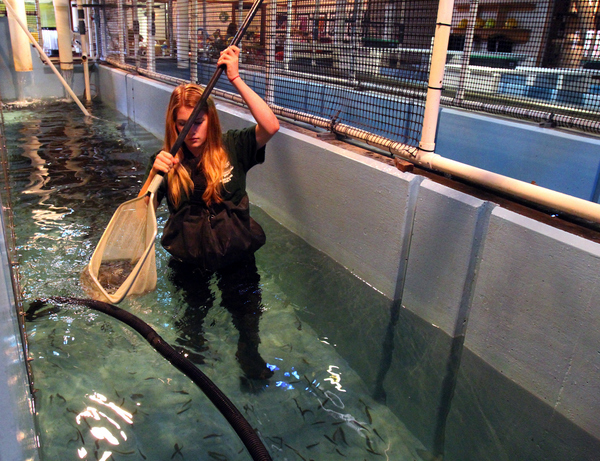By KATIE WATTS / Petaluma Towns Correspondent
Three classes of students began this year time traveling to 1982 in a classroom painted with nature murals and dominated by two massive taxidermied bears, listening to teacher Dan Hubacker tell the story of the United Anglers of Casa Grande High School.
In 1982, wildlife biology teacher Tom Furrer was lecturing on endangered species when he was challenged by a student who asked why they should care since there was nothing they could do. Later, a troubled Furrer tried to walk off his frustration and ended up in the dry streambed of Adobe Creek, close to the Casa campus.
While walking, according to the Anglers’ history, he met the elderly Charlie Malnati, who had lived next to the creek his entire life. Malnati showed Furrer a small group of trapped fingerling steelhead trout. Malnati recalled the creek, alive and healthy, and how, as a child, he loved to watch adult steelhead trout migrate through his backyard.
Adobe Creek had been diverted decades earlier to be a source for city water. It was considered dead, the streambed littered with cars, tires and trash.
Here was Furrer’s answer. He spent two years studying the ecosystem, then challenged his students to get hands-on and local, save the native Adobe Creek steelhead and restore the creekside habitat.
Thirty years later, all water diversions have been removed by the city. Anglers worked, year after year, to clear the streambed of 25 tons of debris and plant trees to provide shade and habitat. Steelhead and salmon return to the creek to spawn. And a hatchery was built on the campus, run by students and overseen by Furrer until his retirement, now by Hubacker.
Hubacker shows the students clippings and videos. Anglers has been profiled in Reader’s Digest and on ESPN and CNN. He talks about how the hatchery was built from private donations.
And he tells about the problems they face. “There are still people littering the creek, poaching or harming the fish. Trees that were good in the beginning, like the arroyo willow, are invasive and create a flood concern.”
The group has been handed new honors. National Marine Fisheries and the University of California, Berkeley, want United Anglers to participate in a study of Chinook salmon. And the NMH and Department of Fish and Game have proposed a full recovery program for the Petaluma watershed, to be implemented with the help of the United Anglers.
These are major honors—but challenges as well. “How do you develop a curriculum for that?” Hubacker asks. “But that’s the level of science these kids will end up learning.”
Students also learn how to run a hatchery—by running one. What the Anglers have is unique as far as Hubacker knows, the only full-scale, student-run hatchery on a high school campus.
Hubacker, 30, has spent half his life involved with this program. “When I began, there were twenty kids or less. Now we’ve got three classes, close to seventy kids. Kids want in-the-field training, they want to feel the connection between the problem and a solution. That has never changed.”
Students don’t just run the hatchery, they’re responsible for the fundraising–$100,000 to $150,000 a year—to keep it running. Another challenge, but once that gives, Hubacker says, “a sense of pride and ownership.” He laughs. “It’s no different from a parent handing over car keys and saying, ‘It’s yours, but you have to pay for gas and insurance.’”
Hubacker was one of the first students in the current classroom. “There was nothing here but a chalkboard, a moose head and countertops.” He gestures to knotty pine walls, installed by Furrer and Furrer’s father; the bears from the old Steinhart Aquarium in San Francisco; murals by artist Thomas Creed; the entrance to the hatchery that’s been made to look like the opening to an old gold mine.“Everything here has a story.”
He tells the classes the story and explains the three decades of work that preceded them. In three years, he says, “I’ve never had a vandalism, never kicked a kid out of class. There’s that sense of pride and ownership.”
After he graduated, Hubacker says, he went to Furrer and said, “Tom, I want your job.”
Furrer laughed and said, “Yeah. We’ll see.” He explained what it would take—the science degree, the commitment.
Hubacker shook his head, remembering his struggles with dyslexia and ADD; failing chemistry three times. “But,” he says, “the words ‘can’t’ and ‘won’t’ aren’t in my vocabulary, and this project wasn’t built on those words.”
So there he sits, in Furrer’s chair. “There’s always a way. Tom believed that and I’ve carried it on.”

